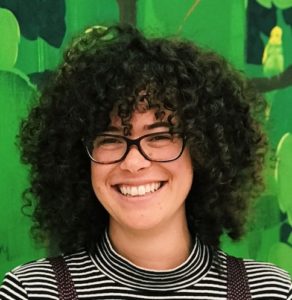Art as Protest, Protest as Art: Ceilidh Munroe on the Art as a Tool for Change Project
Essay available in large font
Art as Protest, Protest as Art
Ceilidh Munroe
It is undeniable that there is an art to protesting. Waves upon waves of signs, held by hands of
all shapes and colours, thrust high into the air, all to demand “We aren’t doing enough. We can do
better”. Hand-drawn phrases or images on cardboard, taped to broom handles and scrap wood.
Banners spray painted or sewn, carried by groups of people marching in a line like an avalanche. The
messages of the makeshift headlines can be anything from humorous (“I like my poutine hot, not my
planet”) to irate (“silence is murder”); stark text or elaborately drawn images.
Often the biggest struggle in communicating one’s fear or anger regarding a certain subject is
the inability to successfully express emotions and make them understood by another person with
different emotions. How can you make someone care about an issue if the most exciting thing you can
muster to inform them is “according to National Geographic only 9 percent of global plastic is
recycled”. Without a human element, it is difficult to engage with a topic enough to affect change.
This intersection – the place where facts and ideas meet meaningful communication to inspire action –
is where art can exist in its most effective state. Art has the ability to inspire consideration,
thoughtfulness, surprise, anger, fear, awe, and joy. Why could it not also inspire direct action? How
many times have you watched a documentary about overfishing, or the fast fashion industry, and
finished it feeling compelled to assess your own implication in whatever issue was just brought to
your awareness? A dry statistic like “every month 1.8 billion people across the globe menstruate, yet
25% of menstruators experience period poverty” inevitably fails to inspire you to address
socioeconomic inequality in access to services. A beautifully crafted Persian rug composed of
tampons and embroidery thread, however, offers a gateway to exploring and connecting with issues
surrounding menstruation and the myriad ways it exists as a taboo in many parts of the world. A
statistic is dry and finite; there is no room to interpret it into the ways it might impact your own life.
An artwork, however, draws you in and asks you to think. Art, in its many forms, encourages
consideration and interpretation. A beautiful landscape photograph displayed with xenophobic phrases
gives one pause when considering times they have heard (or said) such phrases in their own life. Fluid
abstract works paired with poetry viscerally embody how it feels to experience the world from the
position of ‘other’. Protest signs at a march communicate ideas and encourage community
responsibility and mobilization.
Science and technology can give us the facts, but art engenders the passion. The terrifying,
monotonous stream of data throughout COVID-19 made abundantly apparent the fatigue that comes
with consistently ingesting statistics. Eventually desensitized to the proliferation of the disease, we
collectively turned to cultural production to provide hope and make everything feel real. Bare
statistics fail to toe the line between beauty and heartbreak, love and catastrophe. Art bridges that gap
and allows us a communal space to explore our emotions and formulate ideas for how we want to
change. The protest sign may be a statement of fact or opinion, but it is also an expression of passion,
rage, and persistent belief. It calls on others to feel with us, march with us, act with us, make change
with us. The delicate embroidery of Nasim Makaremi Nia, the photographic works of Ethel Brown, or
Violet Drake’s digital paintings can be at once a beautiful object while also a protest sign calling us to
action. Learn about menstruation and the inequitable distribution of sanitation products globally.
Learn about localized xenophobia and othering in Canada. Learn about trans, queer, and differently-abled bodies participating in a system not explicitly designed for them. Allow art to introduce you to
new worlds, to have new thoughts, and to explore new ideas. While some may love the pedantic
exactitude of numbers and statistics, art in its many forms is a universal language for communicating
and harnessing powerful emotions.
 Ceilidh Munroe is a Jamaican-Canadian artist living and working on the unceded territories
Ceilidh Munroe is a Jamaican-Canadian artist living and working on the unceded territories
of the Musqueam, Squamish, and Tsleil-Waututh Nations in Vancouver. She works primarily
in print media with a focus in relief and monotype printing, although this does not exclude
experiments with other media. Her practice is partnered with an interest and passion for fine
arts education that manifests itself in leading workshops, writing, discussions, leading tours,
and more.




